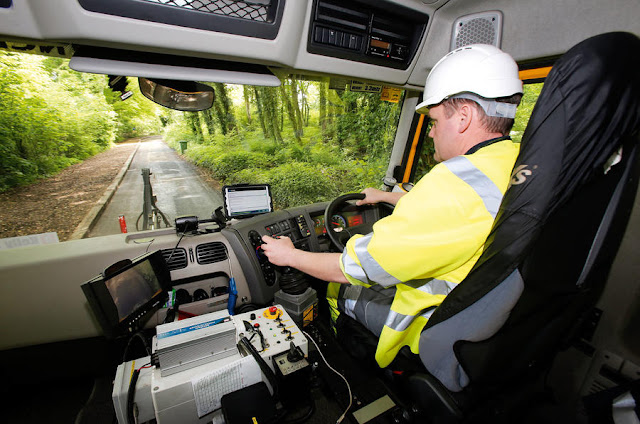A few feet from the busy A31, the latest weapon in the fight against the hole Hampshire County Council works hard.
A bright yellow truck, with a hydraulically operated boom extending from a container on his back, more than a taxi and headed for the road ahead, slowly and noisily making its way along the lay-by, its driver looking for a hole.
When it finds one, it stops the vehicle and extends the 'trunk' to the hole, where it blows compressed air, scattering debris. Hot bitumen emulsion is then sprayed in and around the cavity dry and pure. It seals the hole and creates a bonding layer for the explosion of high-speed targeted aggregates and asphalt mixtures that follow.
Furthermore, proboscis release 'pad coat' of pieces to the asphalt is still tacky, followed by a final spray dried aggregates. GPS and cameras record the position and status of the hole and the data submitted to the board. The time required from start to finish? Three minutes.
Amey, contractors showcased Roadmaster gate highway 295 to the team council, said 17 vehicles, each costing £ 175,000, which is used throughout the country. Paul Anderson, Amey account manager, said the improvements are good for at least three years.
"About 90% of the holes are above 'wearing course'," he said. "This machine allows us to get more holes earlier in their life cycle, preventing more serious damage."
Hampshire County Council Colin Taylor impressed. "The road network we took a real beating four years ago and has increased the number of holes," he said. "The last thing we want is temporary repairs that we have to fix it again. It is a preventative maintenance is good. It is powerful enough to stop the water into a hole - which is what is usually not damaging - and it provides a surface that is sealed and surface friction the new, all with a single operator. If the operator did not see the other holes previously reported, he can fix them, too. "
Whether it was the announcement of the controversial Perth and Kinross Council earlier this year that an increase "the level of intervention holes for improvement" from a hole size of 40mm to 60mm (spokesman said it will continue to improve dangerous hole without delay), or Council of Calderdale boasting repaired 2,000 holes in in April alone, the hole is a hot topic.
They have been since 2012, when the UK has the second-wettest year on record. The road which weakened from below by rising ground water and from above by the tire forcing water into cracks, compressing the surface and breaking it open. In addition, utility companies continue to explore the road, and their fixes are not always standard.
The resulting hole (70% of the council defines a cavity hole 40mm-deep in the street) can be damaged tire and cracked wheels. In a survey earlier this year, 39% of AA members claiming their car had broken down by the hole. Of these, 28% said the wheels, tires and car tracking has been damaged. The survey found that members in Scotland are the worst affected, followed by those in Yorkshire and Humberside.
Asphalt Industry Alliance (AIA), whose members provide maintenance services to the local government, said the annual survey of local councils has revealed that a combination of bad weather, rising traffic levels and what is described as a "decade of underfunding" took their toll on the nation ,
AIA chairman Ian MacKenzie says: ". The local roads are deteriorating at a faster rate than they can be repaired, and a more significant problem for the future is building unseen beneath the surface" the local council agreed. Local Government Association (LGA) said tackling what he called "the crisis" it is becoming increasingly urgent, but the average budget of highway maintenance per the local authorities have fallen by 16%.
LGA transport spokesman Peter Box said: "The board remains holes every 15 seconds last year, but they remain trapped in a cycle that will only leave them able to patch up the road to deteriorate."
Following a call from the local government for extra money to repair the hole, a £ 250 million 'hole fund action' was announced in the Budget this year, and local councils will receive a total of £ 50m each year for the next five years to help pay for the repair of more than four million hole.
The average amount allowed for any improvement of £ 53. A Department for Transport spokesman could not explain how that figure is broken down but said the average repair cost is based on the AIA survey of local councils.
Colin Taylor considers the cost closer to £ 60, but, he says, which does not include the compensation paid to the driver that the car has been damaged. "Council insured can pay a small claim to a certain degree, but will have to pay the excess of any of their own funds," he said. "But self Hampshire guarantee. That means we are responsible for full payment. We look at each claim achievement, but if we had to follow our policies and national guidance, we will reject it."
As Archway Roadmaster 295 extends her trunk to another hole, Hampshire riders will be hoping to fill and seal it for good, thus providing additional spraying asphalt, just to be on the safe side.
Subscribe to:
Post Comments (Atom)




0 Response to "Hole: how much it costs the UK and how they stay"
Post a Comment